Paola Borboni (1900-1995) was one of the greatest Italian stage actresses of the 20th Century. From 1918 on, she played in over 80 films. She was also often heard on the radio and seen on television, but her true passion was the stage.
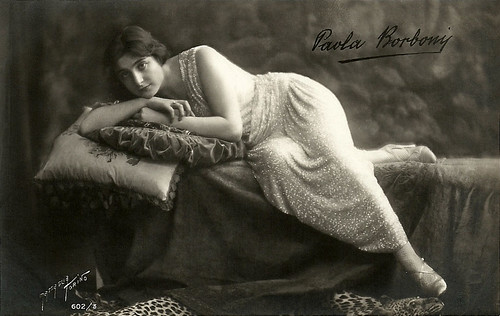
Italian postcard, no. 602/3. Photo: Massaglia, Torino.

Italian postcard by Ed. Vettori, Bologna, no. 1045.

Italian postcard by Ed. Vettori, Bologna, no. 381 Photo: Trevisani, Bologna.
Paola Borboni was born near Parma on New Year's Day 1900, as daughter of a lyrical impresario.
Paola started to act on stage at age 16. Two years later, she was already 'prima attrice' next to Romano Calò and later to Irma Gramatica.
She excelled in particular in the lighter genre, helped by her beauty and her uninhibited behaviour. When playing a mermaid in 1925, she showed her breasts, creating a scandal, but reacting: 'Ever seen a mermaid wearing a coat?'
With the years her roles became more mature and complex. In the 1930s and 1940s, she played for two seasons with Ruggero Ruggeri and in 1934 she also founded her own company. She'd play anything, from Gabriele D'Annunzio to George Bernard Shaw, but Luigi Pirandello was her favourite.
From 1918 on, Paola Borboni also played in films, starting with the silent film Jacopo Ortis/Jacob Ortis (Giuseppe Sterni, 1918), a Milano Film production based on a novel by Ugo Foscolo.
Until 1921, Borboni played in 6 more silent films, directed by Giuseppe Sterni, Giuseppe Guarino and Eugenio Perego.
After that, she exclusively focused on the stage, until the mid-1930s, when she returned with the female lead in Gennaro Righelli's sound film Lo smemorato/The Forgetful (1936), costarring Angelo Musco.
Between 1936 and 1956 her career was at its peak. She had a steady and continuous output of film performances, mainly in supporting roles as in the Tito Schipa vehicle Vivere/To Live (Guido Brignone, 1937).
She played leading parts as in the romantic comedy Ho perduto mio marito/I Have Lost My Husband (Enrico Guazzoni, 1937) with Nino Besozzi, Ricchezza senza domani/Wealth without a future (Ferdinando Maria Poggioli, 1940), and Il viaggio del signor Perrichon/The journey of Mr. Perrichon (Paolo Moffa, 1943). Mostly, however, Borboni played supporting parts in the cinema.

Italian postcard by Ed. A. Traldi, Milano, no. 535. Photo: Badodi, Milano.
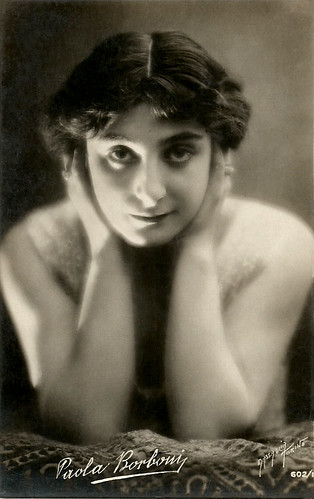
Italian postcard, no. 602/1. Photo: Massaglia, Torino.

Italian postcard, no. 140.
In the postwar era, Paola Borboni played twice on stage under direction of Luchino Visconti: in Vittorio Alfieri's Oreste (1949), and in Arthur Miller's Il Crogiuolo (The Crucible) (1955).
In the 1950s and 1960s, she became famous for her monologues on stage. In these years she was also well-known for her open air theatre performances all over the country.
In the cinema she had substantial or minor parts in several classic titles of the Italian film history. She played the school principal in the comedy Il biricchino di papà/The mischievous Dad (Raffaele Matarazzo, 1943) featuring Armando Falconi, the Russian princess in Sorelle Materassi/The Sisters Materassi (Ferdinando Maria Poggioli, 1944) featuring Emma and Irma Gramatica, the actress Dejanira in La locandiera/The landlady (Luigi Chiarini, 1944), Matilde in Roma ore 11/Rome at 11 (Giuseppe De Santis, 1952), and the aunt baroness in Pietro Germi's Gelosia/Jealousy (1953).
Borboni was a charwoman in William Wyler's Roman Holiday (1953) starring Audrey Hepburn. Other roles were signora Rubini in I vitelloni (Federico Fellini, 1953), the mother of Bruno Sacchi in Terza liceo/High School (Luciano Emmer, 1954), and signora Monti in Casta diva (Carmine Gallone, 1956) starring Antonella Lualdi.
During the 1960s and 1970s, her films included L'oro di Roma/Gold of Rome (Carlo Lizzani, 1961), Arabella (Mauro Bolognini, 1967), and Per grazia ricevuta/Between Miracles (1971), directed by and starring Nino Manfredi.
From 1942 to 1946 Paola Borboni had a relationship with the Sicilian actor Salvo Randone. In 1972 the 72-years old Borboni married poet and actor Bruno Vilar, who was 40 years younger than she was. In 1978 they had a terrible car accident, which killed Vilar and crippled Borboni.
Borboni, though, continued to play in films. Her later roles included Mrs. Baldi in La cage aux folles II (Edouard Molinaro, 1980), sister Theresa in Yes, Giorgio (Franklin Shaffner, 1982), and the marchioness of Querceto in the Johnny Dorelli comedy Occhio, malocchio, prezzemolo e finocchio/Eye, evil eye, parsley and fennel (Sergio Martino, 1983).
Her final film appearance was in Blue dolphin - l'avventura continua/Blue Dolphin - The Adventure Continues (Giorgio Mosa, 1990).
While staying in a home in Varese, Paola Borboni died in 1995 because of a stroke and was buried in the family tomb in Parma. She was 95. All in all, she had played in 86 films in nine decades of cinema.
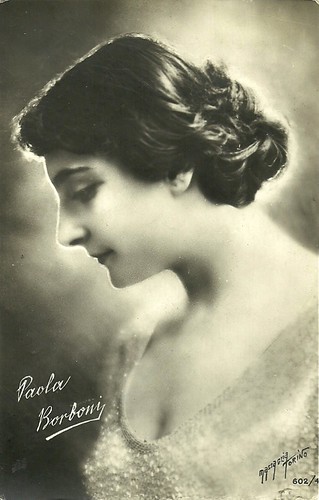
Italian postcard by G. Ballerini & Co., Firenze, no. 602/4. Photo: Massaglia, Torino.

Italian postcard by Ed. Vettori, Bologna, no. 1071. Photo: Trevisani, Bologna.
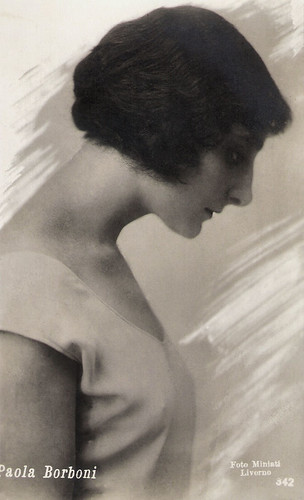
Italian postcard by Casa Editrice Ballerini & Fratini, Firenze, no. 342. Photo: Miniati, Livorno.
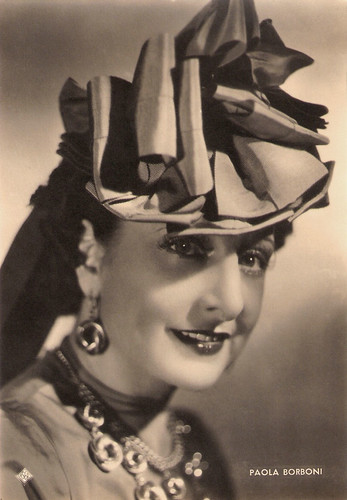
Italian postcard by ASER (A. Scaramaglia Ed. Roma), no. 205, early 1940s. Photo: Vaselli / Lux Film.
Sources: Wikipedia (English and Italian), and IMDb.

Italian postcard, no. 602/3. Photo: Massaglia, Torino.

Italian postcard by Ed. Vettori, Bologna, no. 1045.

Italian postcard by Ed. Vettori, Bologna, no. 381 Photo: Trevisani, Bologna.
Ever Seen A Mermaid Wearing A Coat?
Paola Borboni was born near Parma on New Year's Day 1900, as daughter of a lyrical impresario.
Paola started to act on stage at age 16. Two years later, she was already 'prima attrice' next to Romano Calò and later to Irma Gramatica.
She excelled in particular in the lighter genre, helped by her beauty and her uninhibited behaviour. When playing a mermaid in 1925, she showed her breasts, creating a scandal, but reacting: 'Ever seen a mermaid wearing a coat?'
With the years her roles became more mature and complex. In the 1930s and 1940s, she played for two seasons with Ruggero Ruggeri and in 1934 she also founded her own company. She'd play anything, from Gabriele D'Annunzio to George Bernard Shaw, but Luigi Pirandello was her favourite.
From 1918 on, Paola Borboni also played in films, starting with the silent film Jacopo Ortis/Jacob Ortis (Giuseppe Sterni, 1918), a Milano Film production based on a novel by Ugo Foscolo.
Until 1921, Borboni played in 6 more silent films, directed by Giuseppe Sterni, Giuseppe Guarino and Eugenio Perego.
After that, she exclusively focused on the stage, until the mid-1930s, when she returned with the female lead in Gennaro Righelli's sound film Lo smemorato/The Forgetful (1936), costarring Angelo Musco.
Between 1936 and 1956 her career was at its peak. She had a steady and continuous output of film performances, mainly in supporting roles as in the Tito Schipa vehicle Vivere/To Live (Guido Brignone, 1937).
She played leading parts as in the romantic comedy Ho perduto mio marito/I Have Lost My Husband (Enrico Guazzoni, 1937) with Nino Besozzi, Ricchezza senza domani/Wealth without a future (Ferdinando Maria Poggioli, 1940), and Il viaggio del signor Perrichon/The journey of Mr. Perrichon (Paolo Moffa, 1943). Mostly, however, Borboni played supporting parts in the cinema.

Italian postcard by Ed. A. Traldi, Milano, no. 535. Photo: Badodi, Milano.

Italian postcard, no. 602/1. Photo: Massaglia, Torino.

Italian postcard, no. 140.
A Husband 40 Years Younger Than She Was
In the postwar era, Paola Borboni played twice on stage under direction of Luchino Visconti: in Vittorio Alfieri's Oreste (1949), and in Arthur Miller's Il Crogiuolo (The Crucible) (1955).
In the 1950s and 1960s, she became famous for her monologues on stage. In these years she was also well-known for her open air theatre performances all over the country.
In the cinema she had substantial or minor parts in several classic titles of the Italian film history. She played the school principal in the comedy Il biricchino di papà/The mischievous Dad (Raffaele Matarazzo, 1943) featuring Armando Falconi, the Russian princess in Sorelle Materassi/The Sisters Materassi (Ferdinando Maria Poggioli, 1944) featuring Emma and Irma Gramatica, the actress Dejanira in La locandiera/The landlady (Luigi Chiarini, 1944), Matilde in Roma ore 11/Rome at 11 (Giuseppe De Santis, 1952), and the aunt baroness in Pietro Germi's Gelosia/Jealousy (1953).
Borboni was a charwoman in William Wyler's Roman Holiday (1953) starring Audrey Hepburn. Other roles were signora Rubini in I vitelloni (Federico Fellini, 1953), the mother of Bruno Sacchi in Terza liceo/High School (Luciano Emmer, 1954), and signora Monti in Casta diva (Carmine Gallone, 1956) starring Antonella Lualdi.
During the 1960s and 1970s, her films included L'oro di Roma/Gold of Rome (Carlo Lizzani, 1961), Arabella (Mauro Bolognini, 1967), and Per grazia ricevuta/Between Miracles (1971), directed by and starring Nino Manfredi.
From 1942 to 1946 Paola Borboni had a relationship with the Sicilian actor Salvo Randone. In 1972 the 72-years old Borboni married poet and actor Bruno Vilar, who was 40 years younger than she was. In 1978 they had a terrible car accident, which killed Vilar and crippled Borboni.
Borboni, though, continued to play in films. Her later roles included Mrs. Baldi in La cage aux folles II (Edouard Molinaro, 1980), sister Theresa in Yes, Giorgio (Franklin Shaffner, 1982), and the marchioness of Querceto in the Johnny Dorelli comedy Occhio, malocchio, prezzemolo e finocchio/Eye, evil eye, parsley and fennel (Sergio Martino, 1983).
Her final film appearance was in Blue dolphin - l'avventura continua/Blue Dolphin - The Adventure Continues (Giorgio Mosa, 1990).
While staying in a home in Varese, Paola Borboni died in 1995 because of a stroke and was buried in the family tomb in Parma. She was 95. All in all, she had played in 86 films in nine decades of cinema.

Italian postcard by G. Ballerini & Co., Firenze, no. 602/4. Photo: Massaglia, Torino.

Italian postcard by Ed. Vettori, Bologna, no. 1071. Photo: Trevisani, Bologna.

Italian postcard by Casa Editrice Ballerini & Fratini, Firenze, no. 342. Photo: Miniati, Livorno.

Italian postcard by ASER (A. Scaramaglia Ed. Roma), no. 205, early 1940s. Photo: Vaselli / Lux Film.
Sources: Wikipedia (English and Italian), and IMDb.
1 comment:
Muy bueno e interesante relato de la vida de Paola Borboni.
Un cordial saludo.
Post a Comment